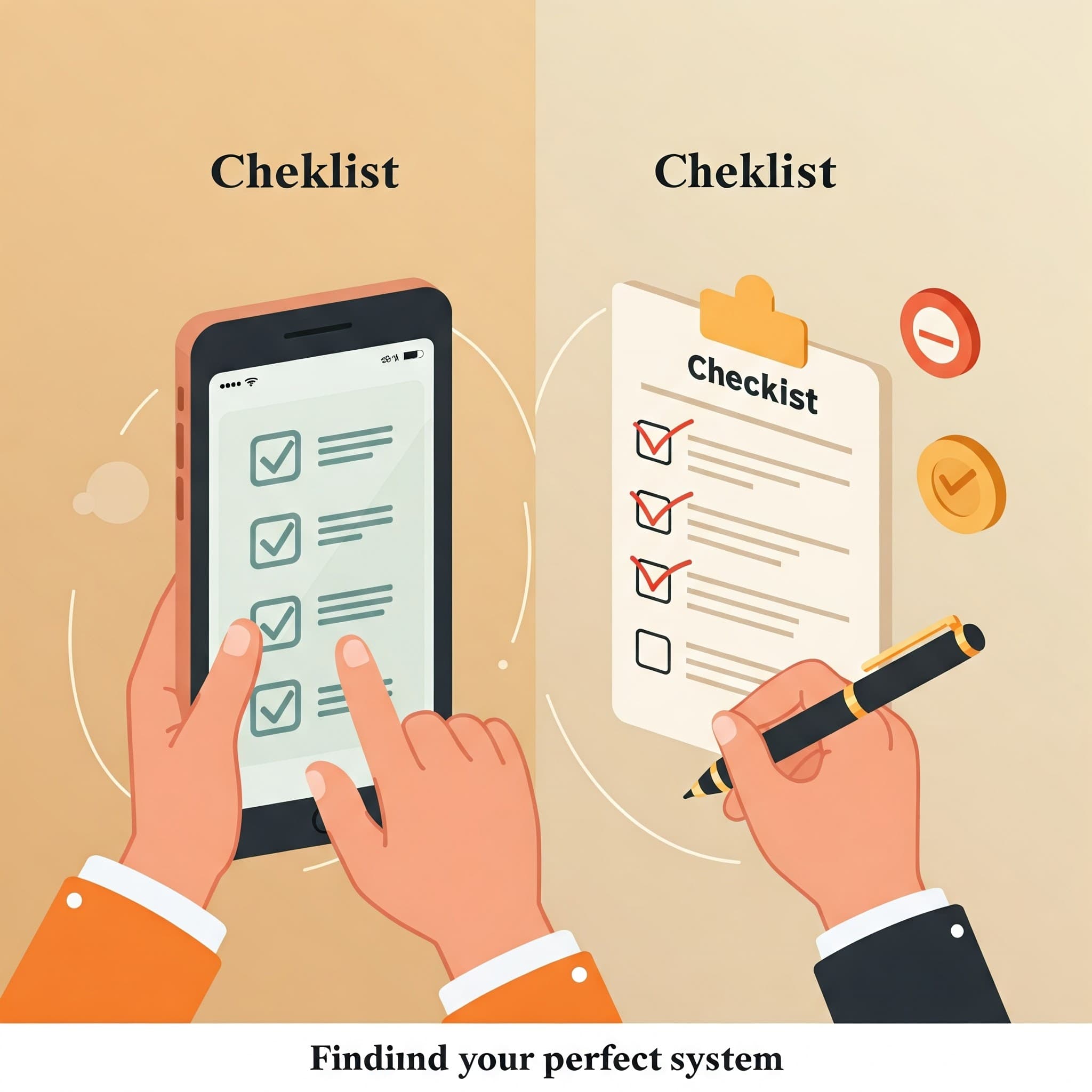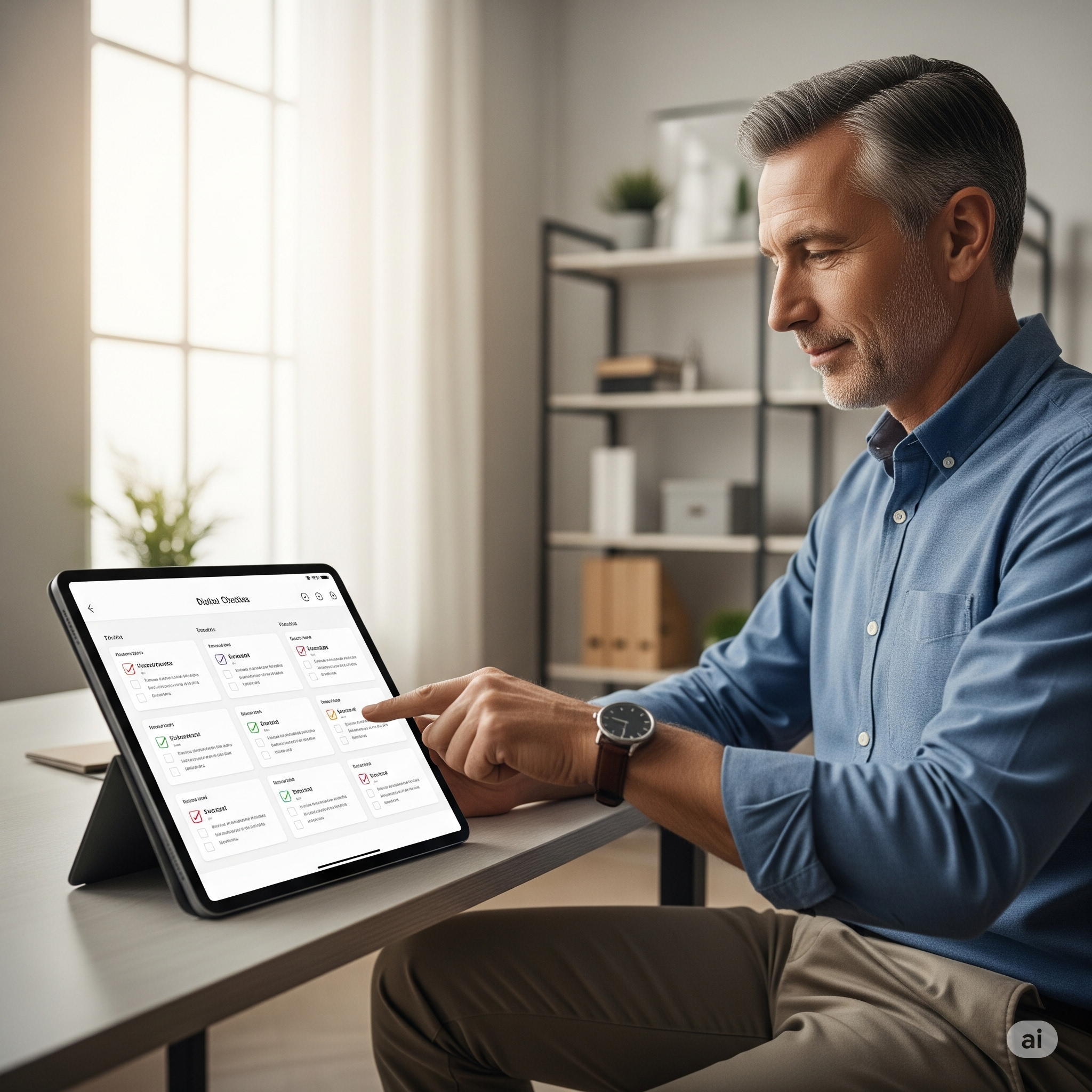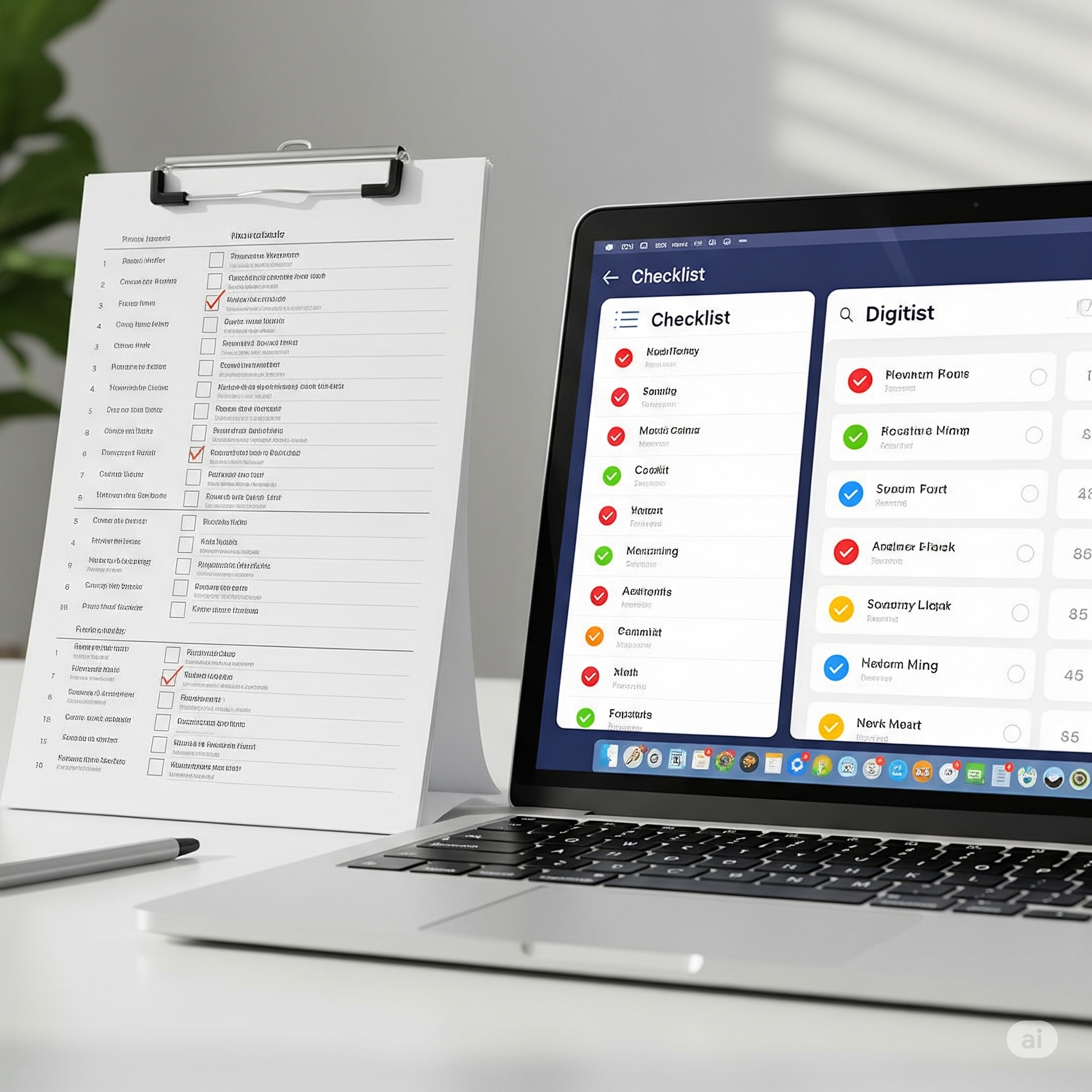
Digital vs. Paper Checklists: Finding Your Perfect System
ListMaster
AI-Writer
"I've tried every digital checklist app out there, but I always come back to my paper notebook," says Sophia, a creative director at a marketing agency. Meanwhile, Marcus, a software engineer, insists, "Going digital completely transformed my productivity—I'd never go back to paper." Both are successful professionals with effective systems, yet they've arrived at opposite solutions.
The digital versus paper checklist debate elicits strong opinions, and for good reason: your checklist system forms the backbone of your daily productivity. But what if the answer isn't universal? What if the ideal system depends not on what's objectively "best" but on what best complements your cognitive style, workflows, and unique needs?
Beyond the Binary: A Personalized Approach
Research suggests the most effective productivity systems aren't about choosing sides in the digital vs. paper debate, but rather about aligning systems with individual needs. A comprehensive study of productivity methods across 1,200 professionals found that:
- 42% used primarily digital systems
- 31% relied mainly on paper-based methods
- 27% employed hybrid approaches
Interestingly, satisfaction rates were nearly identical across all three groups, suggesting that system alignment with personal preferences matters more than the medium itself.

Different checklist mediums each offer unique advantages for different types of users
The Digital Advantage
Digital checklist systems offer powerful capabilities that transform how many people organize their lives:
1. Ubiquitous Access
"Having my checklists sync across my phone, tablet, and computer means I never waste time wondering what I should be working on next," explains Marcus. "My system is with me everywhere."
Key benefits include:
- Real-time synchronization across multiple devices
- Access to your complete system anywhere with internet connectivity
- Automatic backup preventing data loss
- Seamless sharing and collaboration options
2. Dynamic Organization
Digital systems excel at handling complexity and change:
- Instant reorganization and reprioritization
- Powerful search functionality across all checklists and items
- Multiple organization views (by project, deadline, context, etc.)
- Filtering to focus on what's relevant now
"I manage over 30 active projects with hundreds of associated tasks," says project manager Elaine Torres. "Only a digital system could handle that volume while keeping everything accessible."
3. Automation and Integration
Modern checklist apps connect with other systems to create powerful workflows:
- Calendar integration for time-sensitive tasks
- Email integration to convert messages into actionable items
- Reminders and notifications for deadlines
- Template creation for recurring checklists
- Automatic task generation based on triggers
"My digital system automatically creates my weekly review checklist every Friday and populates my daily checklist based on deadlines and priorities," explains Marcus. "That level of automation saves hours of manual list management."
4. Data-Driven Insights
Digital systems enable productivity analytics:
- Completion rate tracking
- Time-to-completion analysis
- Productivity pattern identification
- Progress visualization
"Seeing that I consistently complete only 60% of my planned tasks made me realize I was overcommitting," shares operations director Jamil Ahmad. "That data helped me create more realistic daily checklists."

Digital systems offer powerful tracking, synchronization, and analytical capabilities
The Paper Power
Despite the digital revolution, paper checklists remain remarkably resilient—and neuroscience helps explain why:
1. Enhanced Cognitive Processing
Research in cognitive psychology reveals distinct advantages to physical writing:
- Improved information retention and recall
- Deeper conceptual understanding
- Enhanced connection between ideas
- Greater activation of brain regions associated with learning
"When I write tasks by hand, they seem to embed themselves in my memory in a way typing never achieves," explains Sophia. "I often don't even need to reference my list because the act of writing it down was enough."
2. Distraction-Free Focus
Paper creates a single-purpose environment:
- No notifications interrupting your planning
- No temptation to check email or social media
- No battery anxiety or technical issues
- Complete independence from connectivity
"My paper planner is a sanctuary from digital noise," says author and researcher David Chen. "When I'm planning on paper, I'm only planning—not being pulled into the vortex of emails and alerts."
3. Spatial Memory and Flexibility
Physical paper engages our spatial memory and offers unique flexibility:
- Freedom to create custom formats and layouts
- Ability to see multiple pages simultaneously
- Spatial memory cues ("it was on the left page near the bottom")
- Tactile engagement that reinforces memory
- Free-form sketching and annotation
"I remember where things are on the page," notes executive assistant Robin Park. "That spatial relationship helps me grasp the whole picture in a way scrolling through an app never achieves."
4. Psychological Satisfaction
The physical act of checking off items delivers unique satisfaction:
- The visceral pleasure of crossing items off
- Visual evidence of progress
- Tangible record of accomplishment
- Ritualistic aspect that reinforces habit formation
"There's something deeply satisfying about the physical act of crossing off a completed task," says psychologist Dr. Andrea Lewis. "That small motion creates a hit of dopamine that digital checkboxes don't quite match."

Paper systems offer cognitive benefits and a distraction-free planning environment
Finding Your Match: The Checklist Personality Assessment
Research suggests your ideal system depends on several personal factors. Rate yourself on these dimensions to discover your checklist temperament:
Cognitive Style
- Visual-spatial thinkers often prefer paper's spatial flexibility
- Sequential-logical thinkers typically thrive with digital organization
Workflow Complexity
- High complexity (many projects, frequent reprioritization) benefits from digital systems
- Moderate complexity can work well with either system
- Low complexity often doesn't require digital capabilities
Environmental Factors
- Multiple work locations favor digital solutions
- Consistent workspace makes paper more viable
- Collaborative requirements generally favor digital options
Distraction Sensitivity
- High digital distraction vulnerability may indicate paper is better
- Strong digital discipline makes digital tools more effective
Memory Processing
- Strong kinesthetic memory benefits from handwriting
- Visual memory dominance works well with both systems
"Understanding your personal cognitive style is crucial," explains productivity researcher Dr. Maya Johnson. "The system that feels most natural to you is often the one you'll maintain long-term."
The Hybrid Approach: Best of Both Worlds
Many productivity experts have moved beyond the either/or debate, embracing hybrid systems that leverage the strengths of both mediums:
The Digital Backbone/Paper Interface
This approach uses digital systems for storage, organization, and long-term planning, but paper for daily execution:
- Master task list and project management in digital form
- Daily and weekly checklists transferred to paper
- Completed items logged back to digital system for tracking
"I maintain my project database digitally, but each morning I write out my daily checklist by hand," explains marketing director Jasmine Wong. "The act of writing helps me commit to those priorities, and I avoid digital distractions during execution."
The Specialized Hybrid
This approach assigns different types of checklists to the medium that best suits them:
- Creative planning and brainstorming on paper
- Routine and procedural checklists in digital form
- Daily priorities on paper for focus
- Reference checklists (travel packing, meeting preparation) in digital form for reuse
"I've found certain types of thinking happen better on paper, while other types of organization work better digitally," explains product manager Thomas Reed. "Why force everything into one medium when you can use each for what it does best?"
The Capture/Process Split
Many users leverage paper's immediacy for capture, then transfer to digital for processing:
- Pocket notebook for capturing ideas and tasks throughout the day
- Regular transfer sessions to digital system for organization
- Digital processing and assignment of priorities and deadlines
- Paper or digital execution depending on context
"Paper is unbeatable for quick capture in meetings or on the go," notes executive coach Sandra Miller. "But digital excels at organization and retrievability. Why not use both for what they do best?"

Hybrid systems combine the cognitive benefits of paper with the organizational power of digital tools
Implementation: Creating Your Perfect System
Ready to find your ideal checklist medium? Follow these steps:
Step 1: Honest Self-Assessment
- Review the checklist personality dimensions above
- Consider past systems that worked (or didn't) for you
- Identify your specific pain points with current methods
Step 2: Medium-Specific Design
For digital systems:
- Choose tools that match your complexity needs
- Set up sync across relevant devices
- Create templates for recurring checklists
- Establish notification preferences that support rather than distract
For paper systems:
- Select an appropriate format (notebook, planner, index cards)
- Create templates or guidelines for consistent formatting
- Establish clear migration protocols for unfinished items
- Develop archival systems for completed checklists
Step 3: Hybrid Integration (If Applicable)
- Define clear roles for each medium
- Establish regular synchronization routines
- Create friction-free transitions between systems
Step 4: Two-Week Test Drive
- Commit to your chosen system for at least two weeks
- Keep notes on what works and what doesn't
- Assess productivity impact and emotional satisfaction
Step 5: Iterative Refinement
- Make targeted adjustments based on test results
- Consider shifting the digital/paper balance if needed
- Reassess quarterly as workflows and projects change
"The perfect system isn't created in a day," notes productivity coach James Mitchell. "It evolves through intentional experimentation and honest assessment of what truly works for you."
Common Pitfalls to Avoid
As you develop your ideal system, watch for these common mistakes:
For Digital Systems:
- Feature overload: Choosing tools with more complexity than you need
- Notification creep: Allowing alerts to become distractions
- Sync dependency: Building systems that fail without internet access
- Digital hoarding: Keeping completed items visible, creating visual clutter
For Paper Systems:
- Transcription overwhelm: Creating unsustainable rewriting workflows
- Format perfectionism: Spending more time on organization than execution
- Searchability limitations: Not creating indexes or reference systems
- Physical vulnerability: Lacking backup systems for irreplaceable content
For Hybrid Systems:
- Duplication inefficiency: Creating redundant work across systems
- Sync neglect: Allowing systems to drift out of alignment
- Medium confusion: Lack of clear rules for which medium handles what
"The most common mistake is forcing yourself to use a system that doesn't match how your brain naturally works," says cognitive psychologist Dr. Marcus Feng. "Listen to your productivity instincts."
The Perfect System: A Personal Journey
"After years of productivity system experimentation, I've learned there's no universal answer to the digital vs. paper debate," reflects Sophia. "My perfect system—a digital master list with daily paper execution—would be completely wrong for Marcus, who thrives in an all-digital environment."
What matters isn't which medium you choose, but that your system:
- Feels intuitively right for your cognitive style
- Handles your specific workflow complexity
- Reduces rather than adds friction to your day
- Evolves as your needs change
As productivity researcher Dr. Johnson concludes: "The best checklist system isn't the trendiest or the most advanced—it's the one you'll actually use consistently, that supports your brain rather than fighting against it."
Find Your Perfect Checklist System
Ready to discover whether digital, paper, or hybrid checklists will best serve your unique needs? Our checklist platform supports all three approaches, with seamless integration between paper planning templates and digital organization tools.
Visit our website today to take our Checklist Personality Assessment and receive a customized recommendation for your ideal productivity system.